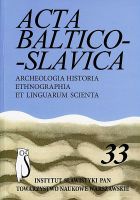Pisownia łatgalska przed stu laty i dziś
Latgalian spelling 100 years ago and currently
Author(s): Anna StafeckaSubject(s): Language and Literature Studies
Published by: Instytut Slawistyki Polskiej Akademii Nauk
Keywords: Latgale (Inflanty Polskie); Latgalian writing; standartization of orthography
Summary/Abstract: Since 1908 Latvians have a unified writing – Antiqua or Latin script. Until that two writing traditions historically have been formed themselves – Fraktur or Gothic script used in Low Latvian texts, and Antiqua or Latin script for High Latvians or Latgalians. It should be mentioned that Latgale’s (at that time called Inflanty Polskie) Latvians were separated by a state border from the rest of Latvians’ ethnic territory for almost 300 years (1629–1917). During this separation, the region developed its own written language based on High Latvian dialect. One of the most essential problems connected with the consolidation of Latvian nation was to unite the spelling. It was changed from Fraktur to Antiqua. There were many unsolved problems of Latgalian writing and ortography. This article provides a description of the development of Latgalian writing from the beginning of the 20th century up to now. A short look into the first Latgalian book, the translation of Gospels “Evangelia toto anno…” issued in Vilnius in 1753 is given, as far as this book is considered to be a foundation of Latgalian orthography until the beginning of the 20th century. It has influenced the development of contemporary Latgalian orthography norms as well. In the 30-ies of the 19th century, some Latgalian authors began to follow the change in Polish orthography, e.g. to indicate the second component of the diphthongs [ai, ei] by the letter j. It should be admitted that the use of the letter j was not consequent, as far as the tradition of the existing written language was too strong. In the second half of the 19th century, the printing prohibition of Latin alphabet took place. At that time hand-written books were quite widespread in Latgale. In the most cases the authors of these books followed the written tradition of the first Latgalian books.
Journal: Acta Baltico Slavica
- Issue Year: 2009
- Issue No: 33
- Page Range: 29-44
- Page Count: 16
- Language: Polish

